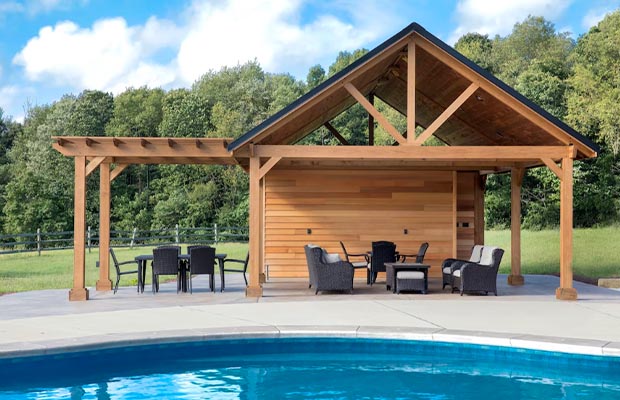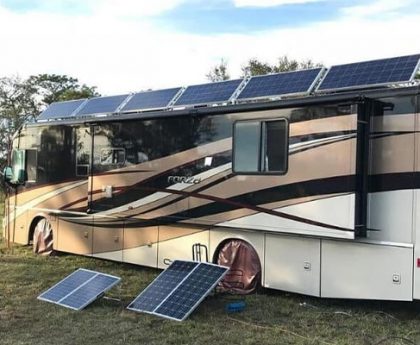Solar panels on the roof come to mind when you consider using solar energy for your home. But if you want to use solar energy to power your home, there are a lot of other places you could install your panels.
A solar gazebo could become an interesting aesthetic feature, generating energy and providing additional usable space
An independent structure called a solar gazebo has solar panels covering its roof, which serves as a cover for the area below. These gazebos offer a covered area with many uses. A solar gazebo could be incorporated with roof gardens on terraces to create an eye-catching aesthetic element while also producing energy and adding extra usable space.
The information you require regarding this well-liked new green energy source is provided below.
Read More: Solar Panels For Mobile Homes
Table of Contents
What Is The Standard Size For Solar Gazebo?
The 10 x 10 pergola is our standard and most cost-effective option and offers a great balance of production and utility. A full-roof solar system is frequently used in conjunction with it.
The pergola usually has between six and twenty solar panels installed. Based on the installs we have done, each solar panel will lower your power bill by an average of $6. An entire 36-panel system can reduce your monthly power bill by about $220.
Again, normal function is frequently more important than production in these outdoor entertaining areas. We frequently try to position these pergolas away from shaded trees to make them produce better solar energy.
Reason For Buying Solar Gazebo
For homeowners who want to benefit from solar energy but encounter one (or more) of the following restrictions, solar gazebos or pergolas are the perfect solutions:
- They do not have enough space on the roof
- They have barrel-tile roofs
- The roof is too old or weak to support solar panels
- The roof does not face the south, thereby limiting exposure
The Benefits Of Solar Gazebo
Solar gazebos or pergolas, as opposed to ground-mounted solar panels, provide a dual-use solution that lets you produce energy while still using the land.
The fact that there is not much that can be done underneath or around solar panels once they have been installed on the ground or on roofs is a major problem.
On the other hand, a gazebo can get around this so you can build a small greenhouse for your house or a romantic sitting area inside. There is no need for more land!
Additionally, solar canopies may provide additional financial advantages depending on where a person lives. By including them in the installation costs overall, for instance, some federal governments provide tax deductions to homeowners going off the grid.
There are a lot of state-level facilities as well to promote investment.
However, this applies to all types of properties, not just houses. eateries, stores, stalls, etc., are a great fit for standalone solar structures as well.
They can generate electricity and cut costs while simultaneously giving customers shade. They are especially useful for outdoor restaurants, bars, BBQ pits, swimming pools, and sports facilities.
Best of all, using solar energy will eventually pay for itself. In practice, it lowers overall operating costs by slashing electricity costs.

What Is The Price Of A Solar Gazebo?
While a fully customized solar structure offers numerous advantages over the long and short terms, it can also be very expensive.
After tax credits, the average cost of a 6-kilowatt solar system is between $1300 and $1500. A bill in the thousands of dollars should be expected if you are constructing a pergola or gazebo from scratch.
Before making a significant choice, you should carefully consider the structure’s size, composition, and overall design. The cost of the panel itself will then be applied.
Rooftop Solar Vs. Solar Gazebos
The rooftop of the majority of homes is where the sun shines the most and has the largest surface area. Mounting solar panels there is typically convenient as little construction or modification is needed. Due to these factors, solar panels that are mounted on the roof continue to be the most common choice among homeowners.
Your roof might not always be the best location for your solar panels, though. Here are a few examples:
- Space constraints: There isn’t enough room on your roof for as many solar panels as you need. (Not what this image represents? Determine the square footage needed for the solar panels here.
- Shade: Direct sunlight may be obstructed from reaching your roof by nearby structures or trees.
- Unfavorable angle or positioning: If your roof doesn’t face south, you won’t be able to generate the most power. For best results, the roof pitch, or angle, must be at the ideal level (30 to 45 degrees).
- Aesthetics: Perhaps you simply don’t like the way they would appear atop your house…
One option to think about is ground-mounted solar panels. Nevertheless, they have a significant drawback: they require substantial amounts of real estate, space that you can’t use for anything else.
The solar pergola, solar gazebo, solar patio cover, as well as solar carport, come into play in this situation. Since each of them serves two purposes, they take up less room than a ground-mounted system would. One of these structures may already be outside your home, which you could easily modify or adapt to hold solar panels.
A built-for-purpose structure that looks great and is optimized for maximum solar energy production is an alternative if you are building one of these structures from the ground up. Of course, choosing a brand-new structure entails raising the price of solar panels to cover the costs of construction.
Tips For Purchasing A Solar Gazebo
To assist you in making an informed choice here is some professional advice. Now, whether you’re thinking about switching to solar to lower your costs or save the planet, you’ll want to and should make the most of it.
But you need to do your research because there are many options and a high price tag. Here’s how to streamline the procedure:
- Numerous estimates, numerous savings: Consumers typically compare as many solar options as they can find to find the best deal, according to a recent report by the US Department of Energy. The price of the installer increases with size. Homeowners who obtain three or more quotes at least can save a total of $5,000 to $10,000. Need we say more?
- The most expensive installers are large ones: Ironically, big solar companies don’t always have the lowest costs. In actuality, the opposite is frequently true. Recent findings from a different government study revealed that larger installers can bill up to $5,000 more than their smaller competitors. Be sure to obtain estimates from both ends of the price range to avoid paying too much.
- Recognize the Watt system: Pricing is determined by wattage when it comes to solar energy. The output of a solar system increases with its size, increasing its cost. Knowing how Price Per Watt (PPW) is calculated will help you compare quotes and, hopefully, find a good deal. To determine PPW, divide the total system cost by the wattage of the system.
- Know the equipment: Examine each and every piece of equipment being installed with care. Naturally, quality products are more expensive, but their long lifespan and warranty policies can enable you to make longer-term financial savings. Furthermore, many mainstream installers have a tendency to raise their prices in exchange for subpar products, so be cautious.





